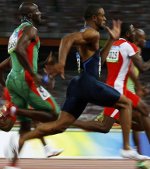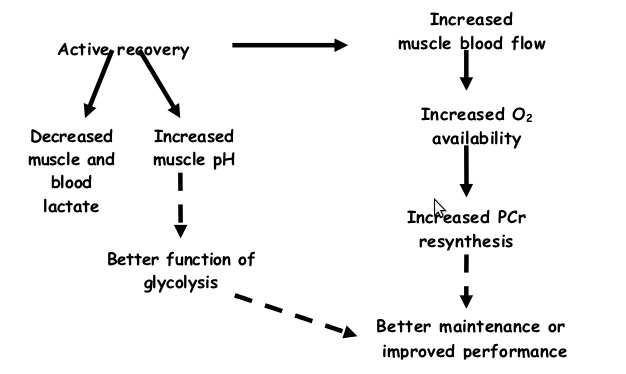The rationale for using active recovery
 Following a sprint of short duration PCr stores are decreased, muscle lactate is high and a disturbance in acid base balance (pH decrease) occurs. The expected beneficial effect of active recovery on performance is based on a faster restoration of muscle homeostasis. Therefore, muscle lactate should decrease and muscle pH and PCr should recover as soon as possible. Muscle
Following a sprint of short duration PCr stores are decreased, muscle lactate is high and a disturbance in acid base balance (pH decrease) occurs. The expected beneficial effect of active recovery on performance is based on a faster restoration of muscle homeostasis. Therefore, muscle lactate should decrease and muscle pH and PCr should recover as soon as possible. Muscle
lactate content may not affect performance during short duration repeated sprints (Bogdanis et al., 1995). However, the increased activation of glycolysis during repeated sprints will increase the H+ concentration and will decrease the muscle pH. A faster restoration of muscle pH may facilitate the function of glycolysis providing the ATP demanded for sprinting (Sayrio et al., 2003). This is because the low pH may affect the function of key glycolytic enzymes (i.e. phosphorylase, phosphofructokinase). Despite muscle lactate, the PCr stores are much more important for performance maintenance during short duration sprints (Bogdanis et al., 1995; Spencer et al., 2008). Therefore, by applying active recovery, it is assumed that the exercise-induced increase in muscle blood flow will enhance muscle oxygenation and this, in turn, will facilitate PCr resynthesis.
Findings from research used magnetic resonance spectroscopy show that increased oxygen availability will facilitate PCr resynthesis (Haseler et al., 1999; Hogan et al., 1999) but there is no evidence to confirm that exercise-induced increase in blood flow will facilitate as well PCr resynthesis. This is because the exercising muscle during active recovery may use this oxygen for other metabolic actions ecxept to PCr resynthesis (i.e. lactate oxidation, ATP recycling for exercise).The importance of adequate blood flow has been shown when local occlusion of muscle blood flow inhibites the PCr resynthesis and lactate removal (Trump et al., 1996; Sahlin et al., 1979). The effect of active compared to passive recovery on some of the important metabolites involved in muscle performance during sprinting are discussed in the following section. A flow chart of events that theoretically take place during active recovery are summarized in Figure.

A hypothetical chain of events that may occur after active recovery between sprints. The discontinuous line indicates unproven effect
